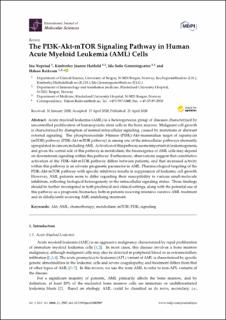| dc.contributor.author | Nepstad, Ina | |
| dc.contributor.author | Hatfield, Kimberley Joanne | |
| dc.contributor.author | Grønningsæter, Ida Sofie | |
| dc.contributor.author | Reikvam, Håkon | |
| dc.date.accessioned | 2021-02-19T11:53:04Z | |
| dc.date.available | 2021-02-19T11:53:04Z | |
| dc.date.created | 2020-05-14T13:32:33Z | |
| dc.date.issued | 2020 | |
| dc.Published | International Journal of Molecular Sciences. 2020, 21:2907 (8), 1-22. | |
| dc.identifier.issn | 1422-0067 | |
| dc.identifier.uri | https://hdl.handle.net/11250/2729208 | |
| dc.description.abstract | Acute myeloid leukemia (AML) is a heterogeneous group of diseases characterized by uncontrolled proliferation of hematopoietic stem cells in the bone marrow. Malignant cell growth is characterized by disruption of normal intracellular signaling, caused by mutations or aberrant external signaling. The phosphoinositide 3-kinase (PI3K)-Akt-mammalian target of rapamycin (mTOR) pathway (PI3K-Akt-mTOR pathway) is among one of the intracellular pathways aberrantly upregulated in cancers including AML. Activation of this pathway seems important in leukemogenesis, and given the central role of this pathway in metabolism, the bioenergetics of AML cells may depend on downstream signaling within this pathway. Furthermore, observations suggest that constitutive activation of the PI3K-Akt-mTOR pathway differs between patients, and that increased activity within this pathway is an adverse prognostic parameter in AML. Pharmacological targeting of the PI3K-Akt-mTOR pathway with specific inhibitors results in suppression of leukemic cell growth. However, AML patients seem to differ regarding their susceptibility to various small-molecule inhibitors, reflecting biological heterogeneity in the intracellular signaling status. These findings should be further investigated in both preclinical and clinical settings, along with the potential use of this pathway as a prognostic biomarker, both in patients receiving intensive curative AML treatment and in elderly/unfit receiving AML-stabilizing treatment. | en_US |
| dc.language.iso | eng | en_US |
| dc.publisher | MDPI | en_US |
| dc.rights | Navngivelse 4.0 Internasjonal | * |
| dc.rights.uri | http://creativecommons.org/licenses/by/4.0/deed.no | * |
| dc.title | The PI3K-Akt-mTOR signaling pathway in human acute myeloid leukemia (AML) cells | en_US |
| dc.type | Journal article | en_US |
| dc.type | Peer reviewed | en_US |
| dc.description.version | publishedVersion | en_US |
| dc.rights.holder | Copyright © 2020 by the authors. | en_US |
| dc.source.articlenumber | 2907 | en_US |
| cristin.ispublished | true | |
| cristin.fulltext | original | |
| cristin.qualitycode | 1 | |
| dc.identifier.doi | 10.3390/ijms21082907 | |
| dc.identifier.cristin | 1811045 | |
| dc.source.journal | International Journal of Molecular Sciences | en_US |
| dc.source.40 | 21:2907 | |
| dc.source.14 | 8 | |
| dc.identifier.citation | International Journal of Molecular Sciences. 2020, 21 (8), 2907. | en_US |
| dc.source.volume | 21 | en_US |
| dc.source.issue | 8 | en_US |

